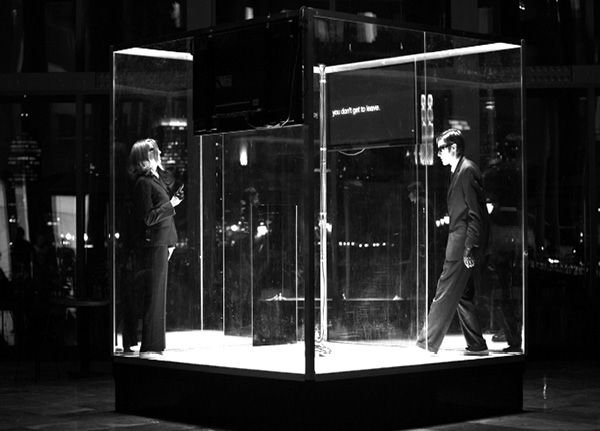
THE ATTENDANTS
first performed on
May 12, 2011
Arts World Financial Center, New York, NY
performed three times in 2011
THE NERVE TANK
Chance D. Muehleck
New York, NY
261020389l261020389i261020389v261020389e261020389t261020389h261020389e261020389a261020389t261020389e261020389r261020389@261020389g261020389m261020389a261020389i261020389l261020389.261020389c261020389o261020389m
nervetank.com
THE ATTENDANTS
THE NERVE TANK
“Living is nothing but consuming time until you die.” –Tehching Hsieh
“The Attendants” is part installation and part interactive multimedia performance. The dominant set piece is an eight-foot, transparent plexiglass cube. Two silent performers dressed in black suits move inside it, and a recording of a conversation about making theater is heard. People can communicate with the performers by texting to them with their cell phones or home computers. The messages appear on two plasma screens flanking the cube. The performance is durational and allows viewers to come and go as they please.
This project was conceived with a heretical question in mind: What would a contemporary sequel to Waiting for Godot look like? The first element we eschewed was the theatrical stage or any sort of traditional playing space. Beckett’s tramps have been stripped of their language and now exist in a sterile, digitized context. The cube itself is both a container for their endless time-games and a transmitter for messages sent by proximate and remote-viewing audiences. The promise of Godot’s arrival is centered on the screens.
Endurance plays a crucial role in “The Attendants,” which is part of its energy. And its energy is one of three components. The other two are time and space. Thinking about “The Attendants” in relation to energy, time, and space guided our development process. The issues we addressed were: How does duration (time) and confinement (space) affect energy (endurance, tempo, etc.) and vice-versa? Ultimately, duration teaches the audience how to experience the piece thematically, and it teaches the performers how to live in the piece holistically.
“The Attendants” is meant to activate the public square or white box of the gallery with interactive technology and live bodies. We wanted to explore what happens when artists give agency to audiences to influence the event. Part of this exploration is contingent on an anonymous or semi-anonymous artistic authorship. Viewers are confronted with the cube and the recorded soundscape; they then must navigate their own responses to it.
We are mindful that goldfish grow to a size that accommodates their bowl. Each performance of “The Attendants” is different, yet each is exactly the same.